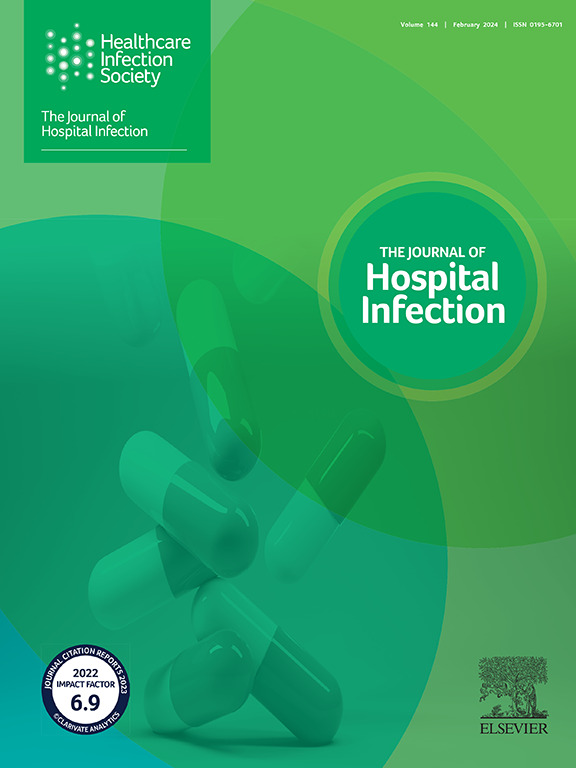A proof of concept evaluation of dry heat as an aerial disinfection method for hospitals: preliminary data for bactericidal efficacy
IF 3.1
3区 医学
Q1 INFECTIOUS DISEASES
引用次数: 0
Abstract
Background
In hospitals, the prevention of healthcare-associated infections requires biocleaning of the patient's immediate environment. Micro-organisms can survive for long periods of time – up to several months – on certain environmental surfaces, resulting in their transmission to the patient through direct contact or via the hands of healthcare workers. Dry heat is a long-recognized antimicrobial process. However, its use as an aerial method of disinfection for hospital surfaces is innovative. An evaluation of bactericidal efficacy is required before any real-world application, to ensure that this method satisfies current standards.
Aim
In this study, we aimed to investigate the effect of dry heat generated at a temperature of 60 °C for 30 min on the bacterial contamination of horizontal surfaces in a room, comparing this method with disinfection by the direct application of a detergent-disinfectant – the current reference method.
Methods
Four supports, made from the materials most commonly found in patient rooms, were inoculated with five different bacterial species representative of hospital ecology and tested. More than 900 bacteriological samples were taken at different times after the disinfection phase.
Findings
The bactericidal activity of the dry heat process was demonstrated by a decrease in bacterial levels of more than 5 log10 cfu/mL in 10 min, regardless of bacterial species or substrate. After 30 min, dry heat was significantly more effective than detergent-disinfectant and mechanical action alone.
Conclusion
Dry heat (60 °C for 30 min) showed bactericidal activity against non-spore-forming vegetative bacteria under the conditions tested in this study. This method can be automated, meets ecological criteria and is not toxic to humans; it may represent a potential alternative for surface disinfection using quaternary ammonium disinfectants against vegetative bacteria, although further investigation is required to confirm efficacy against other clinically relevant pathogens.
干热作为医院空中消毒方法的概念验证和评价:杀菌效果的初步数据。
在医院,预防医疗保健相关感染需要对患者的直接环境进行生物清洁。微生物可以在某些环境表面存活很长时间——长达几个月,导致它们通过直接接触或通过卫生保健工作者的手传播给病人。干热是一个长期公认的抗菌过程。然而,将其用作医院表面的空中消毒方法是一种创新。在实际应用前需要对灭菌效果进行评估,以确保该方法符合现行标准。在本研究中,我们研究了在60°C温度下产生30分钟的干热对室内水平表面细菌污染的影响,并将该方法与当前参考方法直接应用洗涤剂-消毒剂消毒进行了比较。四个支架由病房中最常见的材料制成,接种了代表医院生态的五种不同细菌并进行了测试。消毒阶段结束后,在不同时间采集了900多份细菌学样本。无论细菌种类或底物如何,在10分钟内细菌水平降低超过5 log10 CFU/mL,证明了干热过程的杀菌活性。30分钟后,干热明显比洗涤剂-消毒剂和机械单独作用更有效。在本研究测试的条件下,干热(60°C 30分钟)对非孢子形成的营养细菌具有杀菌活性。该方法可自动化,符合生态标准,对人体无毒;它可能是使用季铵消毒剂对植物性细菌进行表面消毒的潜在替代方案,尽管需要进一步研究以确认对其他临床相关病原体的有效性。
本文章由计算机程序翻译,如有差异,请以英文原文为准。
求助全文
约1分钟内获得全文
求助全文
来源期刊

Journal of Hospital Infection
医学-传染病学
CiteScore
12.70
自引率
5.80%
发文量
271
审稿时长
19 days
期刊介绍:
The Journal of Hospital Infection is the editorially independent scientific publication of the Healthcare Infection Society. The aim of the Journal is to publish high quality research and information relating to infection prevention and control that is relevant to an international audience.
The Journal welcomes submissions that relate to all aspects of infection prevention and control in healthcare settings. This includes submissions that:
provide new insight into the epidemiology, surveillance, or prevention and control of healthcare-associated infections and antimicrobial resistance in healthcare settings;
provide new insight into cleaning, disinfection and decontamination;
provide new insight into the design of healthcare premises;
describe novel aspects of outbreaks of infection;
throw light on techniques for effective antimicrobial stewardship;
describe novel techniques (laboratory-based or point of care) for the detection of infection or antimicrobial resistance in the healthcare setting, particularly if these can be used to facilitate infection prevention and control;
improve understanding of the motivations of safe healthcare behaviour, or describe techniques for achieving behavioural and cultural change;
improve understanding of the use of IT systems in infection surveillance and prevention and control.
 求助内容:
求助内容: 应助结果提醒方式:
应助结果提醒方式:


